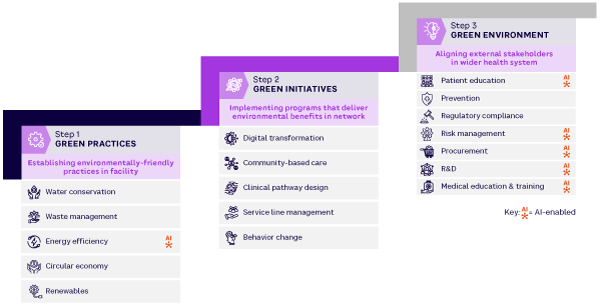In Arthur D. Little’s (ADL’s) work with healthcare clients, we encourage a three-step approach to improving environmental performance (see Figure 1). By addressing environmental, economic, and operational practices at all levels, from core principles to societal integration, healthcare organizations can systematically work toward their sustainability goals and realize long-term benefits at a facility, system, and population level.

1. Green Practices
As a first step, organizations should focus on fundamentals such as water conservation, waste management, energy efficiency, circular economy principles, and investment in renewable sources (e.g., wind turbines, solar panels, and biomass energy). For example, waste-to-energy systems that convert medical waste into usable energy offer a dual benefit of waste reduction and energy generation and have been successfully implemented by several European hospitals.
These basic activities reduce the environmental footprint of healthcare operations and lay the foundation for sustainable progress, starting with Scope 1 and Scope 2 emissions.
2. Green Initiatives
The next step is to integrate sustainability into broader operational areas, recognizing the impact of initiatives like community-based care, clinical pathway redesign, behavioral change, and service-line management can have on Scope 1 and Scope 2.
Telemedicine is being adopted at a good pace, in part because of a ramp-up during the recent pandemic. Virtual consultations reduce the need for physical visits, decreasing carbon emissions associated with transportation while lowering the demand for physical infrastructure such as clinic space. Diagnostic tools can reduce the frequency of unnecessary tests and procedures, lowering resource consumption and patient visits. More robust demand prediction can minimize waste from unused, short-shelf-life drugs and supplies.
Redesigning the model of care to focus on well-being and healthy living, as well as care in alternative settings, can reduce resource consumption and hospital visits while enhancing patient experience and convenience. Linked to this, standardized clinical pathways streamline care processes and reduce unnecessary interventions, leading to more efficient resource use and minimized waste. Hospitals can optimize staffing, scheduling, and patient flow and reduce the need for some patient tests and travel, lowering the environmental impact of healthcare.
3. Green Environment
The third step is to tackle complex challenges that require stakeholder alignment, such as patient education, procurement, regulatory compliance, and risk management. This step also focuses on long-term enablers such as prevention, medical education, and R&D to ensure sustainability becomes deeply integrated into healthcare delivery.
Wearable devices can monitor patient health in real time, alerting the patient/caregiver/
provider about potential health issues before they escalate. The Scope 3 implications of such technologies, however, need to be weighed against the potential benefits. In post-discharge scenarios, they can prevent avoidable readmissions and thus lower the resources consumed by emergency visits and rehospitalization.
With Scope 3 emissions accounting for around 70% of the sector’s greenhouse gas emissions, procurement is key to greening the healthcare supply chain. Procurement teams must collaborate with suppliers to improve transparency and reduce emissions. For example, they can consider the potential reusability of medical instruments, reduced need for packaging, and recyclability of the materials used to manufacture their products. Balancing sustainability with cost, quality, and performance requires thoughtful compromises. Healthcare organizations can adopt eco-friendly procurement strategies, focusing on reducing single-use plastics, sourcing sustainably, and ensuring supplier adherence to environmental standards
R&D can leverage AI to minimize resource consumption and environmental waste in clinical trials and drug discovery (e.g., modeling the impact on certain patient segments without sourcing new datasets). This can lead to a more streamlined process that balances innovation with sustainability goals.
Increasing physician awareness of healthcare’s environmental impact and integrating best practices into medical education and training is essential for promoting sustainability. AI tools, such as those used to diagnose diabetic retinopathy, can help clinicians make more accurate diagnoses and choose optimal treatments, resulting in faster recoveries and reducing the need for more complex procedures, ultimately leading to lower resource consumption.
[For more from the authors on this topic, see: “Greening Healthcare.”]




